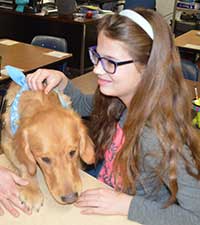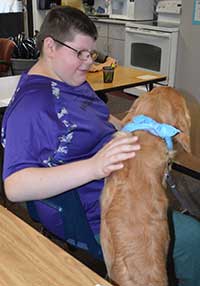It’s probably one of the last places you would expect to see man’s best friend, but Kim Heys thinks it could be the wave of the future.
Picture a troubled youngster sitting in a counselor’s office. The student is upset after a tough morning, which started with trouble at home and is compounded at school for any number of reasons.The problems only escalate and the student shows few signs of settling down, failing even to make eye contact or talk with a counselor — who is running out of ideas to calm him down.
Related Story: Can I Hear the Part About the Squirrel Chase Again? – Therapy dogs are also being used in Grandville to help students in their reading.
That’s when help arrives from an unlikely source.
Into the stressed scene trots a dog specially trained to relate to upset children. The hope is for the dog to swiftly bond with the student, who is instinctively drawn to the animal. Instead of his issues, the student begins to focus on the dog. In short order, he feels comfortable enough to begin a dialogue with the adult.
Heys, a handler for Houston-based Interquest Detection Canines, which provides school drug- and bomb-detection services, was at North Rockford Middle School recently to explain how that scenario could soon be commonplace in schools. The dog Heys brought to Rockford, “Teddy,” will soon be working such scenes at Chicago schools.
“The idea is for dogs to function as a tool for counselors who are dealing with high-stress situations,” Heys said.
While the counselor/student relationship is a large component of the program, it could exceed that, Heys said. She envisions the dogs also being used in drug detection sweeps, as well as helping cognitively impaired students and those who battle high anxiety.

A Natural Fit for Youth
North Rockford Principal Lissa Weidenfeller said the dogs’ versatility is impressive. Since many students have some type of pet at home, they easily adapt to seeing a familiar animal like a dog at school, she said. After they’ve settled down, the children are more likely to be able to talk to counselors about their problems.
“The dogs can be used in many ways depending on the situation,” Weidenfeller said.
Schools may be an ideal spot for the dogs, but Heys noted their talent can also be used in other high-stress environments, such as the courts or a funeral home. Dogs are a natural in defusing stressful situations, she said. Nerves are calmed and youngsters are more likely to discuss their problems.
“People focus on the dog and they calm down,” Heys added. “Dogs have a natural way of being loved, of being a positive aspect.”
Teaching the dogs what they need to learn can take eight weeks before even entering a school. By then, Weidenfeller said, administrators are comfortable that safety measures have been met and the dogs are capable of working with students. Distinctions have to be drawn between a pet at home and an animal trained for school. There are obvious differences, she said.
“Although it appears to students as a school pet, the therapy dog is truly a working dog,” Weidenfeller said. “Schools have to address mental health issues now days. This is a different way for schools to approach and comfort students with mental health concerns.”
Weidenfeller said she definitely would entertain the idea of having the dogs at her school.
“I feel therapy dogs provide another opportunity to connect with students,” she said. “Students who have anxiety, stress, grief, depression or even anger have all experienced comforted by the therapy dogs. The dogs have also helped our students with special needs. The dogs have helped our students to relax, feel safe and supported.”

Helps With Autism Too
North Rockford Middle counselor Holly Normington said the school also has had success working with mechanical cats under the same conditions. She said animals are a natural fit with young people.
“We had one student come in and was angry and upset,” Normington recalled. “Then he saw the dog and that it seemed to want to get on his lap. He asked if it was okay, and it had this calming effect. He took a deep breath and was able to listen to what was going on.”
Normington said the program can also help autistic children communicate.
“Sometimes social cues are missed and I think this is a comfortable way of calming kids down,” she said. “It can have a positive effect on culture and social behavior in school.”
CONNECT
Interquest Detection Canines









